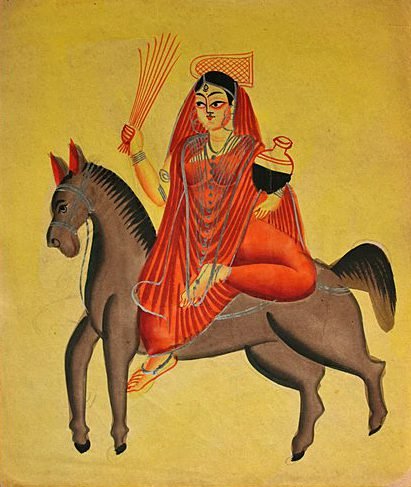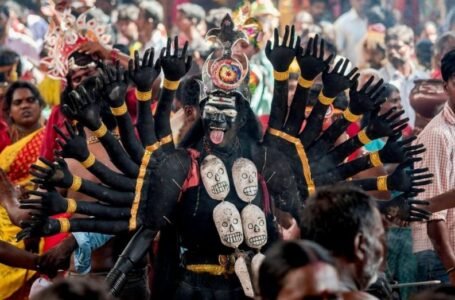Goddess Shitala: The Divine Healer of Ailments

Goddess Shitala is worshipped as the protector from contagious diseases in Hinduism. She is one of the most endorsed by Hindus in India. Her name, derived from “cool” or “calm,” is connected with relief from suffering due to infectious diseases such as smallpox and other fevers. Accordingly, she is worshipped by millions, especially in rural and semi-urban communities where access to medical facilities and proper health care is fairly limited.

Worshipping Shitala Devi is not just a spiritual act; it is a living cultural tradition of many centuries. Her rituals underline the importance of health, hygiene, and community well-being. Shitala Devi, as a deity mixing maternal care unduly and strictness with spiritualism, inspires her devotees to balance physical well-being and spiritual desire.
History of Goddess Shitala
The history of Goddess Shitala’s worship has deep connections with the medical realities in ancient and medieval India. Smallpox, a deadly disease when it ravaged congregations, was at times considered a mark of God’s rage. For this reason, people looked towards spiritual figures for protection, thus Shitala Devi was born a deity who was revered for her power to avert the feared disease.
References to Shitala Devi date back to ancient scriptures like Skanda Purana to many regional classics. Supposedly, in the villages of Northern and Eastern India, where the onset of the epidemic had egregious effects, her ritualistic veneration developed. As the age went by, she spread throughout the Indian subcontinent in tune with several prefects of culture and spirit.
Shitala Devi’s worship acquired wider significance during the medieval period when epidemics had become rampant. Communities began to solicit her blessings for the banishment of diseases; hence her rituals became an indispensable aspect of public health and spiritual practices thereby elevating the goddess’s meaning to include her protection of children, families, and individual health at large.
Shitala Devi’s worship relates closely to folk traditions and rituals of cleanliness and hygiene. Long before modern medicine appeared, her devotees always relied on her holy intervention in curing diseases. Folk songs, ballads, and tales were sung and recounted her miraculous deeds, emphasizing her powers as a saviour and a motherly figure of protection.
Mythology Surrounding Goddess Shitala
There are various stories describing the mythology connected with Goddess Shitala, and in all those myths, she is believed to be incarnated as a mother–strict, yet loving. Her origin differs from region to region, but few themes stay the same, whereby she is depicted as controlling or curing diseases, mostly infantile paralysis and smallpox.
According to popular belief, Shitala Devi came into existence from the divine flames of Lord Brahma, where the Goddess was entrusted with caring for the world against diseases. As such, she became responsible for smallpox in humans if they strayed from proper hygiene and order. However, Shitala has the power to destroy the very sicknesses she causes, fulfilling both roles of infection and healing.
Shitala Devi is always pictured as riding a donkey, broom in hand, and a pot of healing water. The broom signifies cleanliness; the pot contains the cooling water from the river Ganges that cools her devotees’ ailments. This iconography further stresses her dual role of purifier and healer.
One other interesting story recounts the strife between Shitala Devi and Jvarasura, the demon of fever. In the popular folklore, Jvarasura was an infamous huge demon, which led to fever and agony. Shitala Deity had control over him, and he turned into the messenger serving her to represent in spreading smallpox and curing it. Thus, her superior power over calamities and her authority to rule amongst the essence of illness.
There are innumerable regional stories about Shitala Devi’s miracles, showing her role as a saviour and a shield to many children from death. One such myth tells of a mother’s devoted worship that resulted in Shitala Devi saving a child from the grip of a fever that would have surely taken his life. The benevolence and maternal instinct come to the forefront in these tales, forever marking her branch as an eminent mother of the household and a guardian spirit of the family.
Worship of Goddess Shitala
Worship of Goddess Shitala is a communal act of spirituality centred on hygiene, purity, and devotion. The rituals devoted to her vary with each region but usually consist of food, flowers, and water offerings. The rituals are often held outdoors or near rivers and lakes to symbolize the goddess’s association with cleansing and purification.
The day of the worship of the goddess is Shitala Saptami or Shitala Ashtami, falling on Chaitra (March-April). Shitala devotees adopt fasting and have to prepare a special dish called basoda, on the eve before the puja. These dishes, called basoda, are eaten cold to honour the goddess’s cooling nature. Hot food is avoided, as it is believed to invoke her wrath.
Women and children take the supreme part in the performance of this puja. The usual rituals comprise washing house items, sprinkling holy water, and adorning the house with flower garlands. Clay idols or pictures of the goddess are decked with neem leaves, which possess medicinal properties. Devotees pray for protection from sickness and might even vow to visit Shitala temples depending on whether they receive their prayers.
The festivity of Shitala Devi is not merely a religious observance but also a time for camaraderie. They unite to feast, pray together, and do more rituals that foster community health and harmony. While folk songs in her worship are sung, tales of miraculous performances are recited, playing up her worship’s cultural values.
Construction works of her temples are sometimes rudimentary and sacred structures. They function as centres for worship and healing and attract, during epidemics, many pilgrims, which are the devotees seeking her blessings. Some areas organize fairs, complete with stalls selling traditional remedies, religious items, and food.
Locations of Worship
Goddess Shitala worship extends all over the subcontinent, with a wide following among the populace throughout the northern, eastern, and central regions. They may also be found in many rural and urban localities, which is an indication of their popularity.
In West Bengal and Assam, Shitala Devi has taken an important link in the lives of local folks. The worship of this goddess is quite local in origin, with complex rituals done for her protection. The Shitala Ghat in Kolkata is one of the pilgrimage sites where devotees collect in large numbers for prayers and purification rituals.
In Uttar Pradesh and Bihar, the worship of Shitala Devi is popular among rural people. These temples are often situated in close proximity to water bodies because purity and cleanliness are of utmost importance. Devotees gather to honour the goddess and beseech health from her during festive times.
In the states of Rajasthan and Gujarat, Shitala Devi is worshipped as the protector of cattle and families in these forbidding but arid states, for the very fast spread of diseases in such surroundings makes it essential to worship her. Her temples are simple but considered sacred places, in them prayers are made for the health of both men and animals.
In Madhya Pradesh and Chhattisgarh, Shitala Devi worship is much influenced by tribal tradition. Her devotees perform perhaps the most intriguing dances and songs during their rituals, as they worship being through natural means. Community and collective well-being become the focal point of her worship in these regions.
Role in Hindu Mythology
In mythology, Goddess Shitala is closely associated with health, hygiene, and maternal care. In her worship, communities have learnt about the importance of cleanliness and preventive measures in avoiding disease. In her spiritual essence, she is the embodiment of punishment against mercy, thereby teaching her devotees respect for nature and purity.
Shitala Devi’s impact transcends religious practices to the cultural and social levels. She has inspired innumerable folk songs, dances, and a plethora of art forms celebrating her healing powers. Her stories were told and retold over generations to reinforce such concepts as cleanliness, compassion, and service to the community.
Her worship also brings attention to the role of women in spiritual practice; often they are the stewards of their families and the very ones who partake in the royal line of Shitala Devi worship. This seemingly puts the woman in more of a leadership role in community health and hygiene efforts, merging spirituality with social responsibility.
Even in modern times, the teachings of Shitala Devi continue to find relevance, especially in those areas where the health facility is still weak. Her emphases on cleanliness and prevention radically stimulate public health efforts. Her worship serves as a reminder to still respect both spiritual and physical well-being.
Conclusion
Goddess Shitala, the goddess of healing, remains an important figure in Hinduism, granting her devotees protection and solace. Her worship focuses on traditions and community values related to health, hygiene, and faith. Her rituals and legends promote and encourage society to live harmoniously with nature and strike a balance between spirituality and physicality.
Her unending legacy speaks of the power of faith and the human yearning for safety and health. As devotees continue to adore her through acts of devotion and the performance of ritual acts, Goddess Shitala continues to remain a beacon of hope, and healing, and a bridge between God and humans.


